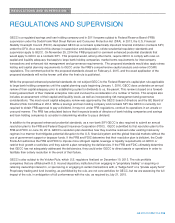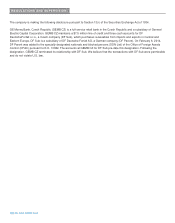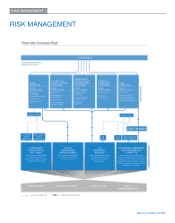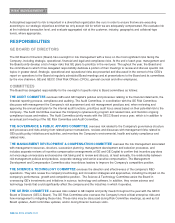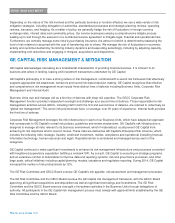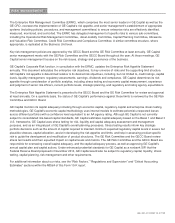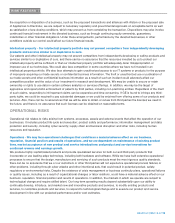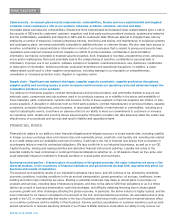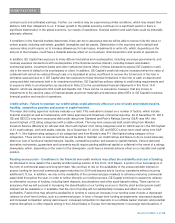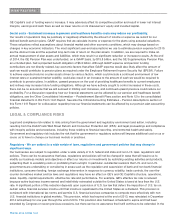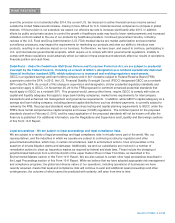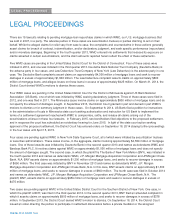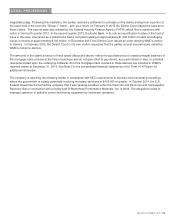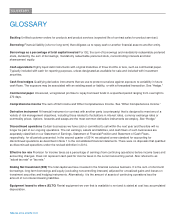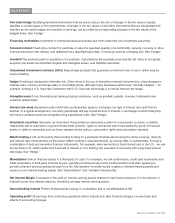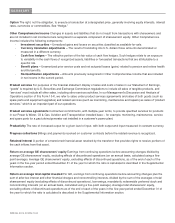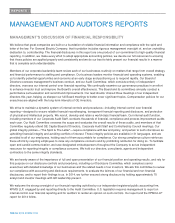GE 2014 Annual Report Download - page 134
Download and view the complete annual report
Please find page 134 of the 2014 GE annual report below. You can navigate through the pages in the report by either clicking on the pages listed below, or by using the keyword search tool below to find specific information within the annual report.
114 GE 2014 FORM 10-K
RISK FACTORS
Cybersecurity - Increased cybersecurity requirements, vulnerabilities, threats and more sophisticated and targeted
computer crime could pose a risk to our systems, networks, products, solutions, services and data.
Increased global cybersecurity vulnerabilities, threats and more sophisticated and targeted cyber-related attacks pose a risk to
the security of GE’s and its customers’, partners’, suppliers’ and third-party service providers’ products, systems and networks
and the confidentiality, availability and integrity of GE’s and its customers’ data. While we attempt to mitigate these risks by
employing a number of measures, including employee training, monitoring and testing, and maintenance of protective systems
and contingency plans, we remain potentially vulnerable to additional known or unknown threats. We also may have access to
sensitive, confidential or personal data or information in certain of our businesses that is subject to privacy and security laws,
regulations and customer-imposed controls. Despite our efforts to protect sensitive, confidential or personal data or
information, we may be vulnerable to material security breaches, theft, misplaced or lost data, programming errors, employee
errors and/or malfeasance that could potentially lead to the compromising of sensitive, confidential or personal data or
information, improper use of our systems, software solutions or networks, unauthorized access, use, disclosure, modification
or destruction of information, defective products, production downtimes and operational disruptions. In addition, a cyber-
related attack could result in other negative consequences, including damage to our reputation or competitiveness,
remediation or increased protection costs, litigation or regulatory action.
Supply chain - Significant raw material shortages, supplier capacity constraints, supplier production disruptions,
supplier quality and sourcing issues or price increases could increase our operating costs and adversely impact the
competitive positions of our products.
Our reliance on third-party suppliers, contract manufacturers and service providers, and commodity markets to secure raw
materials, parts, components and sub-systems used in our products exposes us to volatility in the prices and availability of
these materials, parts, components, systems and services. Some of these suppliers or their sub-suppliers are limited- or sole-
source suppliers. A disruption in deliveries from our third-party suppliers, contract manufacturers or service providers, capacity
constraints, production disruptions, price increases, or decreased availability of raw materials or commodities, including as a
result of catastrophic events, could have an adverse effect on our ability to meet our commitments to customers or increase
our operating costs. Quality and sourcing issues experienced by third-party providers can also adversely affect the quality and
effectiveness of our products and services and result in liability and reputational harm.
FINANCIAL RISKS
Financial risk relates to our ability to meet financial obligations and mitigate exposure to broad market risks, including volatility
in foreign currency exchange rates and interest rates and commodity prices; credit risk; and liquidity risk, including risk related
to our credit ratings and our availability and cost of funding. Credit risk is the risk of financial loss arising from a customer or
counterparty failure to meet its contractual obligations. We face credit risk in our industrial businesses, as well as in our GE
Capital investing, lending and leasing activities and derivative financial instruments activities. Liquidity risk refers to the
potential inability to meet contractual or contingent financial obligations (whether on- or off-balance sheet) as they arise, and
could potentially impact an institution’s financial condition or overall safety and soundness.
Economy/counter-parties - A deterioration of conditions in the global economy, the major industries we serve or the
financial markets, or the soundness of financial institutions and governments we deal with, may adversely affect our
business and results of operations.
The business and operating results of our industrial businesses have been, and will continue to be, affected by worldwide
economic conditions, including conditions in the air and rail transportation, power generation, oil and gas, healthcare, home
building and other major industries we serve. Existing or potential customers may delay or cancel plans to purchase our
products and services, including large infrastructure projects, and may not be able to fulfill their obligations to us in a timely
fashion as a result of business deterioration, cash flow shortages, and difficulty obtaining financing due to slower global
economic growth and other challenges affecting the global economy. In particular, the airline industry is highly cyclical, and the
level of demand for air travel is correlated to the strength of the U.S. and international economies. An extended period of slow
growth in the U.S. or internationally that results in the loss of business and leisure traffic could have a material adverse effect
on our airline customers and the viability of their business. Service contract cancellations or customer dynamics such as early
aircraft retirements or reduced electricity demand in our Power & Water business could affect our ability to fully recover our



